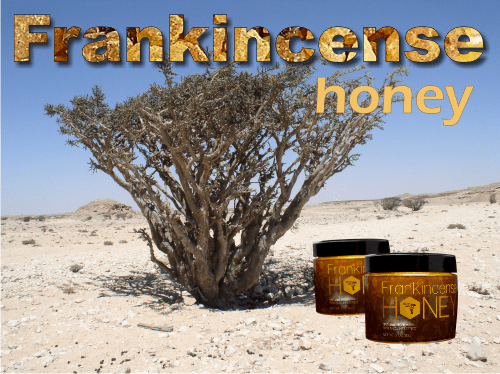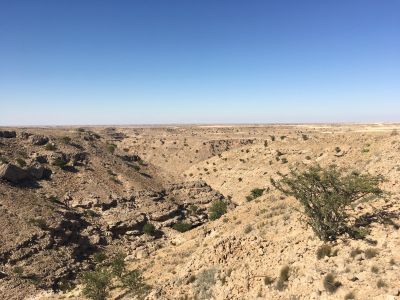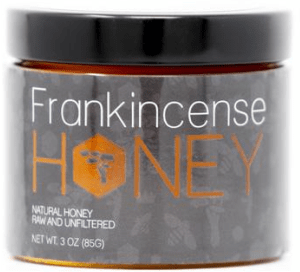Remember frankincense? King of essential oils, gift to the newborn Jesus, repellent to negative energies and evil spirits? Imagine how frankincense honey can be! From a plant that grows in the harshest environmental conditions!
Frankincense honey, aka olibanum honey or boswellia honey, is one of the rarest honey on Earth. For every tablespoon of frankincense honey, 250 kg of manuka honey is produced. That rare!
People who trust alternative medicine know that we can make frankincense honey by simply adding pure frankincense essential oil into honey and than consume it as medicine. And if we cannot afford buying the oil, we can add a few bits of frankincense resin, place them in a jar filled with honey and after a while we have infused frankincense honey.
But there is actually frankincense honey made by honey bees! Not by our regular honey bees, Apis mellifera, but by its tiny relative, Apis Florea.
For those of you who don’t know what frankincense is, or heard of it as being used in churches to fumigate the devil away (!), frankincense is a tree. Priests use the tree’s resin, called simply frankincense, which is formed from the tree’ sap. Pretty much like how it’s done with myrrh or rubber tree. People make a cut in the bark and then wait for the sap to poor (just like blood from a wound) and then harden into resin.
Frankincense tree
The English word frankincense derives from the Old French expression franc encens, meaning “high-quality incense”. The word franc in Old French meant “noble” or “pure”.
Frankincense resin can be produced from 5 main species of trees, belonging to the genus Boswellia. The one that produces true frankincense is Boswellia sacra, native to the Arabian Peninsula (Oman, Yemen) and northeastern Africa (Somaliland) and is a small evergreen tree growing up to 8 metres tall, though usually smaller.
It may have one or more trunks. Its bark has the texture of paper and can be removed easily. The tree grows best in warm climates and tolerates the most critical situations. Often grows on rocky slopes and ravines, up to an elevation of 1,200 m, mostly in calcareous soil. It is abundant in Oman in arid woodland, on the steep, precariously eroding slopes in the mountains of Dhofar, but it is most prevalent in northern Somalia.
Frankincense tree can be grown in pots and brought inside to protect it from freezing temperatures.
Unfortunately, frankincense tree populations are declining, partly due to over-exploitation. Heavily tapped trees produce seeds that germinate at only 16% while seeds of trees that had not been tapped germinate at more than 80%. In addition, burning, grazing, and attacks by the longhorn beetle have reduced the tree population.
 picture credits viktor.manuela and Chris Price via flickr.com
picture credits viktor.manuela and Chris Price via flickr.com
Flowers: Boswellia sacra has tiny flowers of yellowish white, gathered in crowded auxiliary clusters composed of five cream-colored petals, ten stamens and a nectar disk surrounding the ovary. The nectar is sweet enough to attract the local dwarf honey bees and other visitors. The fruit is a capsule that releases its seeds through 3-5 valves.
Nectar: In Oman flowers bloom once per year, in April-May. Flowers of Boswellia sacra (Burseraceae) present a showy nectariferous nectary disc that changes its color from yellow to orange and red during the flower development.
The colors are related to the main period of the stigmatic receptivity, to the dehiscence of anthers with pollen presentation and the nectar secretion. Pollinators preferentially visit the flowers in the “yellow” phase and neglect the “red phase”. This suggests a sophisticated dialogue between the plant and its pollinators. The color change from yellow to red occurs in less than 24h and it is due to the accumulation of anthocyanins (
The resin is obtained by making a small, shallow incision on the trunk or branches of the tree or by removing a portion of the crust of it. The resin is drained as a milky substance that coagulates in contact with air and is collected by hand. It can be harvested all year round, but the finest quality is harvested during the hottest and driest months.
It can be chewed, manufactured into an essential oil or used as incense. It is bitter, pungent with a warming effect that stimulates the circulation, calms the nerves and has antiseptic, expectorant and decongestant properties.
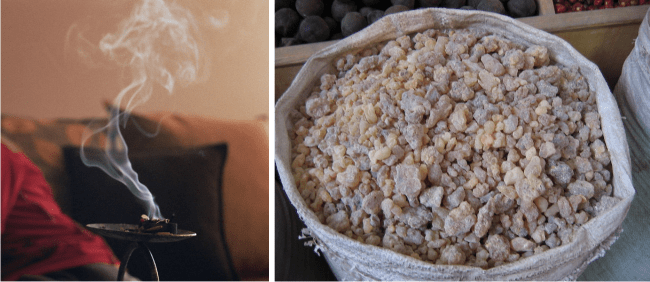 picture credits barbara w and Liz Lawley via flickr.com
picture credits barbara w and Liz Lawley via flickr.com
Facts about frankincense resin:
– The trees start producing resin at about 8 to 10 years old;
– Tapping is done 2 to 3 times a year with the final taps producing the best tears due to their higher aromatic terpene, sesquiterpene and diterpene content;
– The best quality resins are the most opaque;
– Somaliland produces the finest resin and it is said that the Roman Catholic Church purchases most of its stock.
– In Ancient Egypt, embalmers stuffed it inside the bodies and tombs of pharaohs and queens and its ashes were ground into eyeliner;
– the three biblical Magi gifted it to the newborn Jesus Christ, along with myrrh and gold;
– the Prophet Muhammad prescribed it for fumigating houses and treating numerous ailments;
– It is used in various medical traditions, including traditional Chinese herbal medicine, Ayurvedic and western herbalism;
– The famous Jerusalem Balsam, a remedy formulated in 1719 in the pharmacy of the Saint Savior monastery in the old city of Jerusalem contained 4 ingredients: frankincense, myrrh, aloe and mastic. It showed powerful anti-inflammatory, anti-oxidative and anti-septic properties (A.Moussaieff et al., 2005).
Beekeeping in Africa
In Africa there are 3 forms of harvesting honey:
– honey hunting, which in most cases results in the death of the harvested colony. Today this is a discouraged technique;
– traditional beekeeping, mostly based on swarms trapped from the wild and keeping them in woven baskets, clay, bark, grass or log hives, a practice found in majority of African countries;
– modern beekeeping, which means using hives with removable frames, more found in Kenya, Egypt, Tunisia and South Africa.
Beekeepers in North, West and East Africa possess on average 15 hives (Hussein, 2000).
Unfortunately the number of honey bees in Africa is under several threats such as: hunting, habitat loss or diseases (varroa, local viruses, bacteria and fungi), small hive beetles and habitat loss.
Apis florea
Also known as the red dwarf honey bee or the little honey bee, Apis florea is a wild honey bee, which can be temporarily kept using traditional methods. Dwarf honey bees combs are raised or kept temporarily by some beekeepers in northern Oman, by hanging the comb containing brood and adults bees (remaining after removal of top honey-containing portion) using two sticks in its original position or in nook or opening in walls in cultivated/farm area close to where beekeeper resides.
‘Apis’ is the Latin word for ‘bee’ while ‘Florea’ comes from a Romanian name. Why dwarf (honey bee)? Its body length is of 7–10 mm.
Apis florea are indigenous to Asia, but have an enormous area of distribution, extending around 7000 km, from its eastern-most extreme in Vietnam and southeastern China, across mainland Asia along and below the southern flanks of the Himalayas, westwards to the Plateau of Iran and southerly into Oman. This constitutes some 70 degrees of longitude (40°–110° East) and nearly 30 degrees of latitude (6°–34° North). Variations in altitude range from sea level to about 2000 m. (H. Randall HEPBURN et al, 2005). This species occupies a large area that includes rainforests, savannas, subtropical steppes, and semideserts.
Apis florea invaded the African continent in the 1980s (Bezabih et al. 2014) and has expanded its natural distribution into the Arabian Peninsula and the Middle East. A great part of Africa appears suitable for establishment of A. florea (Hepburn and Radloff, 1998), especially once it reaches the tropical regions. (Vincent Dietemann, 2008).
 Apis florea worker honey bee – picture credits Ken Walker
Apis florea worker honey bee – picture credits Ken Walker
The nests of A. florea are exposed and made up of a single horizontal comb (up to 35 cm wide and 25 cm deep) that is built around and attached to tree branches or other support. Nests are often shaded and built in thickets and are not uncommon around human settlements and manmade structures. In the wild, they tend to be found more often in savannah woodlands, forests, or disturbed areas (Engel 2012).
The upper part of the comb forms a crest above and surrounding the supporting branch and is used for storing honey; cells of the crest may be two or three times the length of those below. The top of the crest forms a wide approximately horizontal platform. Below the crest is the area for storing pollen and rearing brood, the pollen occurring as a band between the honey and brood.
They also use propolis as a form of defensive barrier against crawling insects, especially weaver ants. Propolis are sticky bands of resins, applied around the branch supporting the nest to block access to their hive.
Apis florea colonies need to defend themselves against a variety of enemies including ants, hornets, other Apis species. And man!
In defending the nest, worker bees would employ a ‘shimmering’ and hissing behavior, commonly to ward off flying predators. A few worker bees start by raising and lowering their abdomens in the air. This stimulates neighboring bees to do the same, thus creating a rippling effect which spreads across the surface of the curtain of workers, very much like football fans in a stadium! The bees were noted to flex their wings, shimmer, often hiss, and seemed to become more densely packed before eventually flying out at the source of disturbance (Akratanakul, 1977).
The curtain of bees covering the single comb is 3–4 bees thick (about 10 mm) and the head and thorax of only one bee about 4.5 mm, so if an abdomen is visible at the surface of the curtain then there is not enough beelength of bee to actually reach cells of nectar and still have the abdomen visible to the outside.
Not only do the bees tilt their bodies to present a cluster of abdomens (hence stings), but they simultaneously change their neighbour-neighbour spacing patterns from unordered to a significantly more condensed and ordered pattern. The combined changes in posture, position and packing of Apis florea on disturbance with smoke is a behavioural analogue of the “testudo” approach of the ancient Romans! (Christian W.W. PIRK et al., 2002)
What is frankincense honey?
Sweet, rich, slightly piney and floral – this is how frankincensehoney.com describes its product. Their honey is harvested on the mountain wadis of southern Oman. A wadi is a valley formed from drainage courses of water, but distinguished from river valleys, or gullies, in that a wadi is generally dry year round, except after a rain.
These wadis are where beekeepers place their hives. Frankincense trees represent more than 90% of all the trees present there and dwarf honey bees seem to preferentially seek frankincense nectar and pollen, thus producing a pretty monofloral honey.

Sensory description: sweet with a floral aroma
Moisture: 15.6 %
Electric conductivity: 438.5 μs/cm
pH: 4.6
Acidity:17.11 meq/Kg
Fructose: 40.9 g/100g
Glucose: 29.65 g/100g
Fructose/Glucose ratio: 1.37
Sucrose: 0.79 g/100g
No traces of heavy metals content (copper, arsenic, cadmium, lead, mercury)
(analysis report dated January 2020, conducted at Al Joudah Food Technology and Trading LLC)
A HPLC Analysis Report performed in august 2020 by Aromatic Plant Research Center showed the presents of tiny amounts of boswellic acids:
– 3-acetyl-11-keto-beta Boswellic Acid: 0.813 μg/mL
– Alpha Boswellic Acid: 0.201 μg/mL
– Beta Boswellic Acid: 0.800 μg/mL
– Alpha-acetyl Boswellic Acid: 0.416 μg/mL
– Beta-acetyl Boswellic Acid: 0.431 μg/mL
· Beta Boswellic Acid is the most abundant acid in the essential oil and is reported to be effective as anti-inflammatory/anti-arthritic, immunomodulatory, anti-tumor, anti-asthmatic and in Chron’s disease, working equally effective when taken orally or applied topically. (S. Singh et al. 2008).
· Acetyl-11-keto-beta Boswellic Acid was shown to have anti-anaphylactic and mast cell stabilizing activity. (Pratibha Pungle et al., 2003)
· 3-acetyl-β-boswellic acid (AβBA)and alfa boswellic acid (αBA) and other constituents were shown to have good brain availability. (Kathleen Gerbeth, 2012)
The amounts of boswellic acids found in this honey are not high. And though the essential oil is successfully used in alternative medicine, even to treat cancers of all kinds, brain included, one cannot get cured by eating frankincense honey. However, this is an extraordinary food that will keep your body healthy and will prevent potential diseases. Small amounts of a remedy will act on the principle of homeopathy and keep your body on guard.
The red dwarf honey bees not only collect the yellow nectar and pollen from the flowers but also the resin that drains from the cuts made by men in the trees. They use it to make propolis, which will insure the health of the hive. Based on how active they are, they really enjoy it.
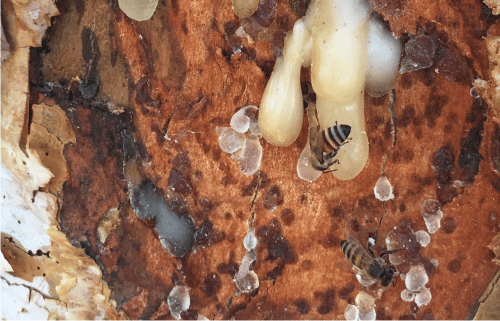
Where can we find frankincense honey?
In the wadis of southern Oman, a beekeeper with more than 20 years of beekeeping experience brings his hives and harvest the precious honey. Recently he and his team have received help from a few enthusiastic people who though of giving the trees and community extra value, and then donate part of their income from the honey to the Somaliland Biodiversity Foundation, to support construction of a frankincense conservation nursery in Somaliland.
Frankincensehoney.com is their new website and you can order this precious honey from there. It’s not cheap, it cannot be, the harvest is scarce and it’s consumed locally before it can reach an international market.
However, its price is still under the price of a true highly therapeutic grade manuka honey (which is around $520/kg)! Though it is 17,000 times rarer.
Other references:
Apis florea: morphometrics, classification and biogeography, https://www.apidologie.org/;
Availability of Nectar and Pollen Sources for Honey Bees in Oman, https://www.researchgate.net/;
THE BIOLOGY AND BEHAVIOUR OF THE HONEYBEE APIS FLORE A by J.B. FREE; http://cataglyphis.fr/;
Apis florea – Red Dwarf Honeybee; https://wiki.nus.edu.sg/
https://en.wikipedia.org/wiki/Frankincense
https://en.wikipedia.org/wiki/Boswellia_sacra;
https://www.padil.gov.au/pests-and-diseases/pest/main/135537

